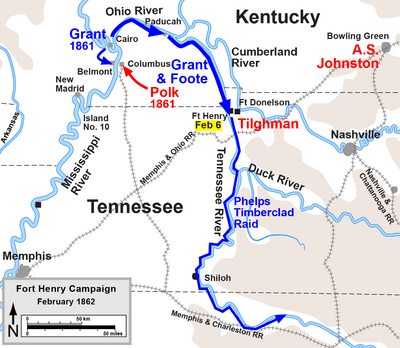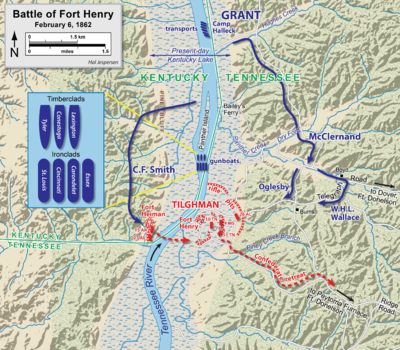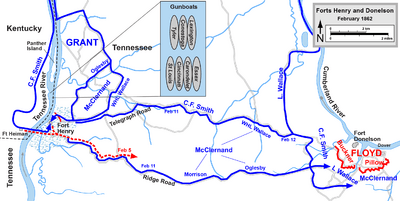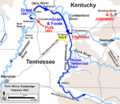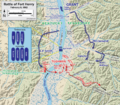Battle of Fort Henry facts for kids
Quick facts for kids Battle of Fort Henry |
|||||||
|---|---|---|---|---|---|---|---|
| Part of the American Civil War | |||||||
 Bombardment and capture of Fort Henry, Tenn, 1860s lithograph by Currier and Ives |
|||||||
|
|||||||
| Belligerents | |||||||
| Commanders and leaders | |||||||
| Units involved | |||||||
|
|
||||||
| Strength | |||||||
| 15,000 7 ships |
3,000–3,400 |
||||||
| Casualties and losses | |||||||
|
40 |
79 |
||||||
The Battle of Fort Henry happened on February 6, 1862, in Stewart County, Tennessee. It was an important battle during the American Civil War. This battle was the first big win for the Union side and for Brig. Gen. Ulysses S. Grant in the western part of the war.
On February 4 and 5, Grant's soldiers landed near Fort Henry on the Tennessee River. Grant planned for his army to attack the fort on February 6. At the same time, Union gunboats, led by Flag Officer Andrew Hull Foote, would attack from the river. Heavy rain and the fort's bad location, which was almost underwater, helped the Union. The fort's commander, Brig. Gen. Lloyd Tilghman, gave up to Foote's ships before Grant's army even arrived.
Winning Fort Henry opened the Tennessee River for Union ships to travel south. After the fort surrendered, from February 6 to February 12, Union ships called ironclads destroyed Confederate boats and railroad bridges along the river. On February 12, Grant's army marched about 12 miles (19 km) to fight Confederate troops at the Battle of Fort Donelson.
Contents
Why the Battle Happened
In early 1861, Kentucky was a "border state" that tried to stay neutral in the American Civil War. This neutrality ended on September 3. That's when Confederate Brig. Gen. Gideon J. Pillow took control of Columbus, Kentucky. This town was important because it overlooked the Mississippi River and had a railroad.
Two days later, Union Brig. Gen. Ulysses S. Grant took Paducah, Kentucky. This was a major transportation spot at the mouth of the Tennessee River. After this, neither side respected Kentucky's neutrality. This meant Kentucky could no longer act as a safe zone between the North and the South.
By early 1862, Albert Sidney Johnston was in charge of all Confederate forces from Arkansas to the Cumberland Gap. But his soldiers were spread out too much. His forces included 12,000 men in Columbus, 4,000 men in Bowling Green, Kentucky, and 4,000 men at Forts Henry and Donelson. Forts Henry and Donelson were the only defenses for the important Tennessee and Cumberland Rivers. If the Union could control these rivers, they would have two direct ways to invade western and eastern Tennessee.
| Key Leaders at the Battle of Fort Henry |
|---|
|
The Union army in the West had a problem: their commanders didn't work together well. They were in three separate groups. By January 1862, they couldn't agree on a plan. President Abraham Lincoln wanted a big attack by February 22. Even though he was usually careful, Maj. Gen. Henry W. Halleck agreed to Grant's idea to attack Fort Henry.
Grant quickly got ready. He left Cairo, Illinois, on February 2. His invasion force had 15,000 to 17,000 soldiers. They were supported by the Western Gunboat Flotilla, led by United States Navy Flag Officer Andrew Hull Foote. The flotilla had four strong ironclad gunboats and three lighter "timberclad" gunboats.
General Johnston, the Confederate commander, was told by his government to defend the rivers and railroads. He moved his forces south to face another Union general. His officer, General P.G.T. Beauregard, wanted him to attack or make the forts stronger. But Johnston refused. Fort Henry was known to be a weak spot because it often flooded. It had about 3,000 to 4,000 men and heavy guns, which was thought to be enough to stop ships. A new fort was being built nearby on higher ground.
Fort Henry's Design and Location
Fort Henry was a five-sided fort made of earth. It covered about 10 acres (0.04 km2) on the east bank of the Tennessee River.
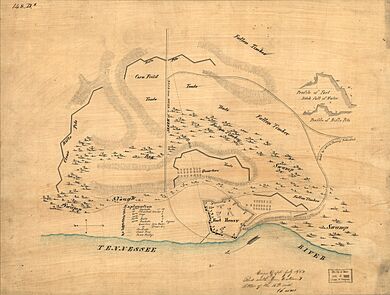
In May 1861, Isham G. Harris, the governor of Tennessee, asked Daniel S. Donelson to build forts on the rivers. Donelson found good spots, but they were in Kentucky, which was still neutral. He then chose a spot for a fort on the Cumberland River, which would be named Fort Donelson.
Donelson then moved about 12 miles (19 km) west to the Tennessee River and chose the site for Fort Henry. He named it after Senator Gustavus Adolphus Henry Sr.. He put Fort Henry on the east bank of the Tennessee River so one group of soldiers could defend both forts. Donelson thought it was unlikely that both forts would be attacked at the same time.
Unlike Fort Donelson, Fort Henry was built on low, swampy ground. Hills across the river overlooked it. This was a big mistake because the fort often flooded during heavy rains or high tides. Sometimes, more than half of the fort, including its gunpowder storage, was underwater. However, it had a clear view for its guns for 2 miles (3.2 km) downriver. Donelson's team didn't like the site, but it was approved anyway.
The fort was made to stop ships on the river, not to defend against large army attacks. Building started in mid-June 1861, using soldiers and slaves. The first cannon was tested on July 12, 1861. Not much happened for the rest of 1861 because other forts were more important. In late December, more soldiers and 500 slaves arrived to build a smaller fort called Fort Heiman across the river. In January 1862, Brig. Gen. Lloyd Tilghman took command of both Forts Henry and Donelson, with about 4,900 men. At Fort Henry, there were about 3,000 to 3,400 men. Many of them had old flintlock rifles from the War of 1812.
By the time of the battle, Fort Henry had 17 guns. Eleven guns faced the river, and six were for land attacks. There were two very heavy guns, a 10-inch (250 mm) Columbiad and a 24-pounder rifled cannon. The rest were 32-pounder smoothbore guns. There were also two 42-pounders, but no ammunition for them. When the river was at its normal level, the fort's walls were 20 feet (6.1 m) high and 20 feet (6.1 m) thick at the bottom. But in February 1862, heavy rains made the river rise, and most of the fort, including the gunpowder storage, was underwater.
The Confederates also put down "torpedoes" (which are like modern naval mines) in the river. These were supposed to explode if a ship hit them. But they didn't work because the water was too high, and the mines leaked.
The Battle Begins
On February 4 and 5, Grant's army landed in two different places. One group landed north of the fort to stop the Confederate soldiers from escaping. Another group was supposed to take Fort Heiman on the Kentucky side of the river and use its guns against Fort Henry. But heavy rains on the night of February 5 slowed down Grant's troops. So, the battle became mostly a fight between the Union ships and the fort.
General Tilghman realized that Fort Henry would soon fall. Only nine of his guns were still above water and working. He decided to leave some artillery in the fort to fight the Union gunboats. He ordered most of his soldiers to march to Fort Donelson, which was 12 miles (19 km) away. Fort Heiman was left empty on February 4. Union ships fired on Fort Henry on February 5, causing 4 Confederate casualties. Most of the soldiers left Fort Henry on February 5. Union cavalry chased the retreating Confederates, but bad roads stopped them from catching many. Tilghman spent the night on a boat upstream. He returned to Fort Henry just before dawn on February 6.

On the morning of February 6, Foote's seven Union gunboats arrived at Fort Henry. They started firing around 12:30 p.m. from about 1,700 yards (about 1,554 meters) away. The fort fired back for over an hour. Foote used his four ironclad gunboats in a line, with the three timberclads behind them. The high water level of the river helped the Union ships. The fort's guns were low, so they could only hit the strongest parts of the ironclads.
All four Union ironclads were hit many times. The USS Essex was badly damaged when a 32-pound shot went through it. It hit the boiler, sending hot steam everywhere. Thirty-two crew members were killed or hurt, including the commander. The Essex could not fight for the rest of the campaign.
Aftermath and River Raids
After 75 minutes of fighting, Tilghman surrendered to Foote's fleet. The Union ships had moved closer, to about 400 yards (370 m) away. Before the battle, Tilghman had told his men he would fight for an hour to give them time to escape. With only one cannon still working and very little gunpowder left (because the storage was underwater), Tilghman ordered the Confederate flag to be taken down and a white flag raised. The Union gunboats stopped firing right away.
The fort was so flooded that Tilghman had to sail out in a small boat to surrender on the Cincinnati. Twelve officers and 82 men from the fort surrendered. About 15 men were killed and 20 were wounded. The Confederate soldiers left all their guns and equipment behind. Tilghman was held prisoner for many months.
Tilghman wrote in his report that Fort Henry was in a "wretched military position." Grant sent a short message to Halleck: "Fort Henry is ours." He also said he would take Fort Donelson soon. Halleck sent a message to Washington, D.C.: "Fort Henry is ours. The flag is reestablished on the soil of Tennessee. It will never be removed."
Grant and his soldiers arrived at Fort Henry around 3 p.m. on February 6, only to find that the fort had already surrendered. By February 8, Fort Henry was completely underwater. On February 7, the Union gunboats Cincinnati, St. Louis, and Essex returned to Cairo, flying Fort Henry's captured Confederate flags upside down. A newspaper called the Chicago Tribune said the battle was "one of the most complete and signal victories."
The fall of Fort Henry quickly opened the Tennessee River for Union ships and supplies. Right after the surrender, Foote sent Lieutenant Phelps with the three timberclad gunboats, Tyler, Conestoga, and Lexington, upriver. Their job was to destroy Confederate military buildings and supplies. The ironclads were damaged and slower, so they weren't used for this mission.
The raid went as far as Muscle Shoals, which was as far as ships could go on the river. The Union ships and their raiding parties destroyed supplies and an important railroad bridge about 25 miles (40 km) upriver. They also captured several Southern ships, including one ironclad that was being built. The people of Florence, Alabama, asked Phelps to spare their town and its railroad bridge. Phelps agreed, as he didn't think the bridge was important for the war. One account from the 1800s said Phelps's raid was "a perfect success." It showed how weak the Confederacy was in that area. It also showed that many people in Tennessee, Mississippi, and Alabama supported the Union. Phelps even recruited some pro-Union Southerners to help him. The Union gunboats returned safely to Fort Henry on February 12.
After Fort Donelson also fell to Grant's army on February 16, the Tennessee and Cumberland Rivers became Union waterways. This meant Union troops and supplies could move easily. Just as Grant thought, taking these two forts and rivers forced the Confederate forces at Columbus to leave that city and western Kentucky.
Fort Henry Today
Even though it's connected to Fort Donelson, the Fort Henry site is not managed by the U.S. National Park Service. It is now part of the Land Between the Lakes National Recreation Area. When the Tennessee River was dammed in the 1930s to create Kentucky Lake, the remains of Fort Henry were covered by water forever. A small light for boats, far from the shore, marks where the fort used to be. Fort Heiman was on private land until October 2006. Then, 150 acres (0.61 km2) of land around that fort were given to the National Park Service. Now, it's part of the Fort Donelson National Battlefield. Some of the old trenches can still be seen.
Images for kids
-
Bombardment and capture of Fort Henry, Tenn, 1860s lithograph by Currier and Ives
-
Brig. Gen. Ulysses S. Grant, USA
-
Relief map of Fort Henry, drafted by General Cullum w/ his notations
-
The Union gunboat attack on Fort Henry, sketched by Alexander Simplot for Harper's Weekly
See also
 In Spanish: Batalla de Fort Henry para niños
In Spanish: Batalla de Fort Henry para niños






